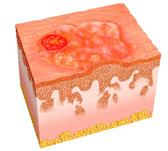Skin Allergies

Urticaria and Angioedema (Hives and Swelling)
Urticaria and angioedema are common disorders that can cause severe discomfort. A board certified allergist will obtain a thorough history and perform allergy and blood tests to determine if an allergic trigger or an immune abnormality is present. Many cases of chronic hives and swelling have an unknown cause.
There are many treatment options that can be individualized for each patient. Treatment for urticaria and angioedema include antihistamines, Xolair and immunosuppressants.
Atopic Dermatitis (eczema)
Atopic dermatitis is a common form of skin allergy that involves a combination of skin inflammation from allergies and skin barrier breakdown. Eczema commonly presents along with nasal allergies, asthma and food allergies. Treatments for eczema include moisturization, avoiding irritants, decreasing inflammation, managing infection and immunotherapy. A variety of over-the-counter emollients can be used for moisturization to prevent skin barrier breakdown.
Avoiding irritants that contact the skin can prevent inflammation from occurring. Topical corticosteroids are often used in reducing inflammation and antibiotics are used to treat any existing infections. Allergy testing is performed to identify the presence of any food or environmental allergies. Immunotherapy can be used to treat atopic dermatitis if environmental allergies are present.
Allergic Contact Dermatitis

Allergic contact dermatitis is a common form of skin allergy that presents as an itchy rash due to exposure to contact allergens. Common allergens include metals, topical antibiotics, perfumes, cosmetics, and preservatives. Many other allergens that come in contact with the skin daily through exposure to common materials can also trigger contact dermatitis. Irritant dermatitis resembles allergic contact dermatitis but is caused by an environmental irritant instead of an allergen.
Diagnosis and treatment focuses on allergic patch testing placed on the patient's back for 48 to 96 hours to determine if a reaction takes place. A patient can then take measures to avoid contact with allergens once they are identified.
